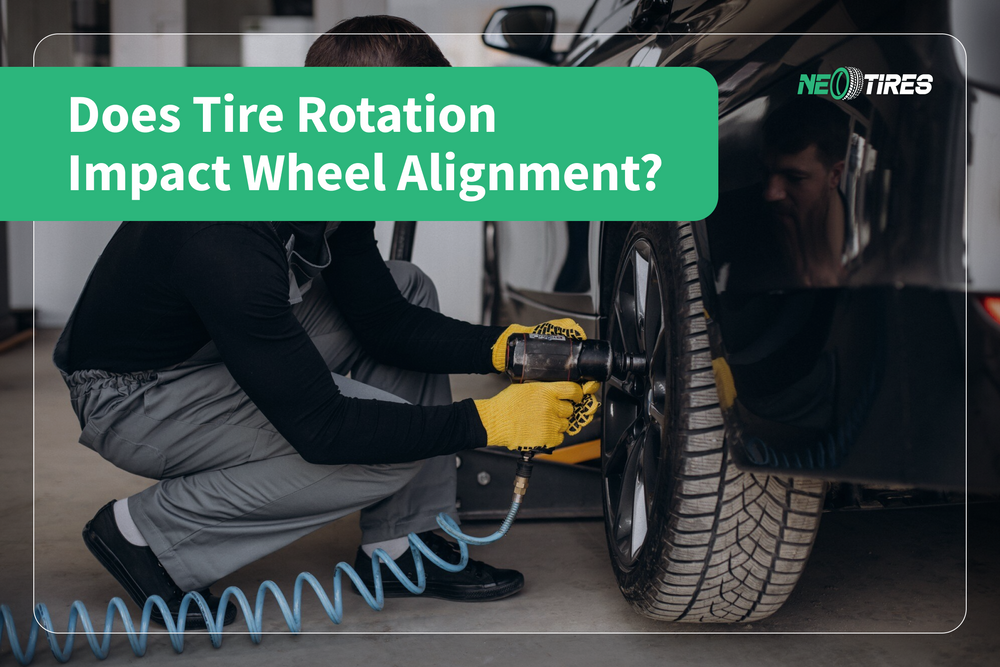In the previous articles, I talked about both tire rotation and wheel alignment as separate topics. These 2 subjects seem to be quite clear for enthusiasts and car owners. Still, a question seems to bother everyone: does tire rotation affect the wheel alignment or not?
These 2 aspects are crucial for optimal long-term tire serviceability. Car owners mistakenly think that one action will consequently lead to the impact of the other. We won't keep you in suspense too long. And I'll answer this question right now: tire rotation has nothing to do with wheel alignment. These 2 procedures are done separately from each other and do not influence each other. Now that you have calmed down a bit by finding out the answer, let's see what these 2 actions have in common or not.
Tire Rotation vs. Wheel Alignment
Let's bring some clarity between these two terms. Tire rotation involves changing the tires between them. Technicians use different tire rotation schemes depending on the type of car traction. The purpose of this procedure is to ensure an even wear of all car tires and to remove stress and pressure on the same tire.
Think about it: front-wheel drive cars receive the biggest impact specifically on the front wheels. Rear-wheel drive cars, respectively, receive all the stress on the rear tires.
Due to the stress caused by braking, acceleration, and cornering, the traction tires wear out much faster than the "secondary" ones.
In these circumstances, the technicians rotate them following specific schemes. As a result, the tires wear evenly, significantly improving the traction, grip, and overall performance of the car. It's a great way to extend the life of tires and optimize the driving experience.
Wheel Alignment And Suspension
Wheel alignment has more to do with the entire suspension system than with the tires. It involves correcting the angles between the wheels and the suspension setup so that in the end the tires have a correct and stable patch contact with the road. In cases where the patch contact is affected by an inappropriate angle, the wheel will pull the car to one side and generate steering vibrations.
Alignment and Rotation: Any Connection?
Car owners often think that if they had a tire rotation done recently, their wheel alignment could have been somehow affected. In reality, however, these 2 procedures are in no way connected. In the same sense, if you recently had a wheel alignment, this does not mean that you should not rotate the tires.
When the technicians perform the wheel alignment, they work directly on the suspension setup. That is the place where the angles of the tires are adjusted.
In contrast, the technicians have no attribution with the suspension setup when they rotate the tires. They remove the tire and move it either parallel, perpendicular, or diagonally (depending on vehicle traction). Respectively, their rotation has nothing to do with the suspension setup.
In this context, you should perform tire rotation and wheel alignment independently of each other. At the same time, you should know that one procedure is unlikely to affect the other unless you give the car to a completely clumsy mechanic.
Wheel Alignment and Tire Rotation: How Often?
Manufacturers usually come with a set of tire recommendations including tire rotation frequency in the driver's manual. It would be good to follow the suggestions in it. If the instructions are missing, follow the general recommendations that suggest a rotation once every 5-7,000 miles.
The recommendation regarding wheel alignment assumes a frequency of once every 1-2 years. Many drivers perform these procedures simultaneously.
Why Should You Not Skip Tire Rotation? and Wheel Alignment?
Both procedures are extremely important for optimal tire serviceability, as well as for maintaining the suspension system in good condition.
Tire rotation brings more benefits than drivers think. As I mentioned before, this procedure improves the overall performance of the vehicle by the fact that the tread wear is uniform. But this is not the only benefit.
Timely tire rotation brings a positive contribution to car handling. Why? Because optimal handling is the result of a firm grip on the road. And when the tires have ever worn, the vehicle is much more stable and safe, eliminating hydroplaning effects.
In the same context, tire rotation has a beneficial impact on the steering system, minimizing its vibrations to zero, especially at high speeds.
Why Should You Not Skip Wheel Alignment?
You will feel a wiser fuel consumption if the wheel angles are correct. Wheel misalignment impacts the rolling resistance of the tire, making the engine seek more power to meet the demand. As a result, the engine consumes more fuel.
Apart from this, the driver has a smooth riding experience. In the context of improper angles, the vehicle is always pulled to one side of the road, which creates driving discomfort and wastes the suspension components.
The lack of problems with wheel alignment ensures an optimal response of the vehicle in tense situations. With acceleration, sudden braking, and turning, you want the car to respond efficiently. In case of a misalignment, each of the actions provides a delayed response.
Tire Rotation and Alignment: FAQs
Does Alignment Include Tire Rotation?
Not exactly. Matter-of-factly, these 2 procedures are not directly related to each other. Alignment involves correcting the angles of the wheels relative to the road and takes place at the level of the suspension. On the other hand, rotation involves exchanging the tires with the place and has nothing to do with the suspension. The goal of both processes is more or less the same: to reduce tire uneven wear and extend their longevity. Finally, both processes are extremely important because they increase tire performance and driving safety. It is common for drivers to perform these maintenance procedures simultaneously. However, it is not mandatory as they can be done separately as well. What matters most is not to ignore any of these procedures.
Do I Need To Rebalance Tires After Rotation?
Both rotation and balancing are essential procedures for the integrity of your tires. You should not ignore any of these processes. However, you can balance the tires together with tire rotation and separately from this procedure. Tire balancing should be done around every 12,000 miles unless the manufacturer recommends otherwise. Tire rotation is usually done once every 5,000-7,000 miles, depending on the type of tire. Still, it is beneficial to do the balancing along with the rotation for your peace of mind.
Should I Get An Alignment Before or After Tire Rotation?
Professional mechanics recommend first rotating the tires and only then aligning them. Still, the reverse process is not a critical mistake.
Is Alignment The Same As Balancing And Rotation?
All 3 terms are fundamental for the integrity of your tires. However, they do not mean the same thing. Indeed, the purpose of the 3 maintenance procedures is more or less the same: reducing uneven tire wear, improving performance and safety, and increasing tire longevity. However, each process takes place differently. The alignment is done at the level of the suspension, where the mechanic corrects the angles of the wheel relative to the road. Rotation involves changing the tires in different schemes. Ultimately, balancing involves adding small weights to the tires to even out the weight distribution on them.
Why Trust Us?
The passion for tire science and the huge tire industry has gradually transformed us into professionals in this field. Tires are more than a piece of rubber rolling on the road. They can ensure impressive performance in the most difficult road conditions and conquer the most unconquerable terrains. Everything is due to the science and technologies behind them, which we are simply crazy about.
This motivated us to found NeoTires, which is a platform where we not only offer tires for any need but also educate drivers on how to have a better driving experience. Each team member has over 10 years of experience. As such, we know how to test tires from different perspectives, understand their pluses and minuses, and match drivers' specific needs with suitable tires for ultimate performance and reliability.
Here at NeoTires, you have a wide range of products for any vehicle and any need. But that's not all we offer. Feel free to benefit from our qualified consultation and assistance in any question related to tires. We are happy to help you in improving your driving experience through our expertise. Drive safe and choose your tires wisely!





